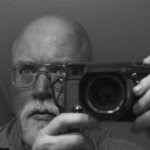The 40mm Lens Makes a Comeback
There are several hypotheses as to why a 50mm lens came to be thought of as the “normal” lens, i.e., the focal length for 35mm film that best approximated how the human eye perceived the view in front of the camera. My best guess is that Leica decided to make a 50mm lens and it became the standard that others followed. But is it the most “normal” view?
I have read from several sources that the length of the diagonal of the 35mm frame would be the focal length that bests approximate a normal view. Given that a 35mm frame is 24mm x 36mm and using the Pythagorean Theorem, 362 + 242 = 432 (approximately). So, 43mm would be the ideal “normal” lens (not the one that fits the norm, but the one that best approximates the aspect seen by the eye. Applying the same hypothesis to medium format film (6cm x 6cm), the ideal normal focal length would be around 85mm. Okay, that seems about right. So why are there so few 40mm lenses out there?
Well, 40mm (+/- 3mm) aren’t that rare in the fixed lens rangefinder world. My Olympus SP has a 42mm lens, and I recall my Konica Auto S3 having a 38mm lens. The ubiquitous Canon G-III QL17 has a 40mm lens. So, 40mm seems normal for a fixed lens rangefinder, but 50mm is more normal for an interchangeable lens rangefinder? Hmm. Perhaps if 40mm had been the normal focal length for interchangeable lens rangefinders, the 35mm focal length would have suffered in sales. Whatever the case, there appears to be a sudden resurgence in 40mm lenses for interchangeable lens cameras. And I like the focal length.
To be fair, Leica sold a 40/2 Summicron on its Leica CL in the early 1970’s, and the follow-up Minolta CLE had a similar 40/2 Rokkor lens. An Elmarit-C 40/2.8 appeared briefly but was quickly pulled from production. But for the next 25 years, fixed-lens rangefinders disappeared from inventories, along with their 40mm lenses. Then, as quickly as they became extinct, we see:
45mm Planar on the Contax G cameras
40/2.8 Sonnar LTM lens on the Rollei RF (a Cosina made body). The 40/2.8 lens on the Rollei 35 was a killer lens, so this was a nice reintroduction to an old favorite.
43/1.9 Pentax was released in two versions, an autofocus model for the Pentax SLR, and an LTM model for Leica mount cameras.
40/1.4 MC Nokton (Voigtländer) for Leica M-mount cameras.
40/1.4 SC Nokton (Voigtländer) for Leica M-mount cameras (a single coating version for those seeking the older, lower contrast qualities for black and white shooting).
40/2.8 Pentax pancake lens for Pentax SLRs.
40/2.8 Nikkor pancake for Nikon SLRs.
45/2.8 Tessar pancake for Contax/Yashica SLRs.
I know I missed one or two, but eight lenses in this focal length range makes me a happy man. For rangefinder users, I think that the new Voigtländer 40s are the best news. This is a very small lens that you won’t mind carrying all day that can shoot in low light. It's the smallest fast “normal” lens I’ve had since the 50/1.5 Zeiss for the old Contax II mount. I wonder if Leica is ever going to design and sell another rangefinder lens. If they do, I hope that it is a 40mm Summicron or Summilux, and that they make it small. Until then, my 40/2 Rokkor and 40/1.4 Nokton will serve me well.


<< Home